My Call
In the last blog post, my favorite image was the Wood Stork sunrise silhouette because of the spectacular sky colors and the impeccable image design. I crouched to include the perfect proportion of both inlet and sky.
Your Call?
Which of today’s four featured DeSoto images impresses you the most? Leave a comment and let us know why you made your choice.
Fort DeSoto #3 Late Registration Discount Info
I am offering a $500/person late registration discount for the third DeSoto Fall IPT. David Pugsley sent me a text yesterday letting me know that DeSoto has gotten hot again recently.
|
|
|
All images from SEPT/OCT/NOV at Fort DeSoto. Click on the image to enjoy a larger, sharper high-resolution version. Clockwise from upper left to center: Piping Plover flapping after bath, juvenile Laughing Gull with feather, American Oystercatcher with sea urchins, Willet foraging in surf, American White Pelican juvenile swimming, skimmer/tern/shorebird blast-off blur, American White Pelican in flight, Black-bellied Plover stealing lugworm from Marbled Godwit, Roseate Spoonbill staring. |
The Fall 2023 Fort DeSoto Instructional Photo-Tours
Fall 2023 Fort DeSoto Instructional Photo-Tour #3
3 1/2 Days: Tuesday 31 October through the morning session on Friday 3 November 2023. $1399.00 (was $1899.00) — includes three working lunches. Limit six photographers.
Fall 2023 Fort DeSoto Instructional Photo-Tour #4
3 1/2 Days: Tuesday 14 November through the morning session on Friday 17 November 2023. $1899.00 includes three working lunches. Limit six photographers/Openings: three.
Fall Bird Photography at Fort DeSoto
Fort DeSoto, located just south of St. Petersburg, FL, is a mecca for migrant shorebirds, terns, and gulls in fall. There they join hundreds of egrets, herons, and night-herons that winter on the T-shaped peninsula. With any luck at all, we should get to photograph one of Florida’s most desirable shorebird species: Marbled Godwit. Black-bellied Plover and Willet are easy, American Oystercatcher is pretty much guaranteed. Great Egret, Snowy Egret, Great Blue Heron, Tricolored Heron, and White Ibis are easy as well and we will almost surely come up with a tame Yellow-crowned Night-Heron or two. And there should be some quality Brown Pelican flight photography. In addition, Royal, Sandwich, Forster’s, and Caspian Terns will likely provide us with some good flight opportunities as well. Though not guaranteed, Roseate Spoonbill and Wood Stork might well be expected. And we will be on the lookout for a migrant passerine fallout in the event of a thunderstorm or two.
On this IPT, all will learn the basics and fine points of digital exposure. Nikon and Canon folks will learn to get the right exposure every time after making a single test exposure, and SONY folks will learn to use Zebras so that they can be sure of making excellent exposures before pressing the shutter button. Everyone will learn how to approach free and wild birds without disturbing them, to understand and predict bird behavior, to identify many species of shorebirds, to spot the good situations, to choose the best perspective, to see and understand the light, and to design pleasing images by mastering your camera’s AF system. Most importantly, you will surely learn to evaluate wind and sky conditions and understand how they affect bird photography. And you will learn how and why to work in Manual mode (even if you’re scared of it). The best news is that you will be able to take everything you learn home with you so that you will be a better photographer wherever and whenever you photograph.
|
Clockwise from upper left to center: Long-billed Curlew, juvenile Tricolored Heron, Marbled Godwits, Great Blue Heron, juvenile Pectoral Sandpiper, Wood Stork, smiling Sea Scallop, Ruddy Turnstone scavenging needlefish, Great Blue Heron sunset silhouette at my secret spot, and southbound migrant tern flock blur. |
The Details
There will be a Photoshop/image review session during or after lunch (included) each full day. That will be followed by Instructor Nap Time.
These IPTs will run with only a single registrant (though that is not guaranteed). The best airport is Tampa (TPA). Once you register, you will receive an e-mail with Gulfport AirBnB/VRBO information. If you register soon and would like to share an AirBnB with me, shoot me an e-mail. Other possibilities including taking a cab to and from the airport to our AirBnB and riding with me for $50/day. This saves you both gas and the cost of a rental car.
A $600 deposit is due when you sign up and is payable by credit card. Balances must be paid by check one month before the trip. Your deposit is non-refundable unless the IPT sells out with six folks, so please check your plans carefully before committing. You can register by calling Jim during weekday business hours at 863-692-0906 with a credit card in hand, or by sending a check as follows: make the check out to: BIRDS AS ART and send it via US mail here: BIRDS AS ART, PO BOX 7245, Indian Lake Estates, FL 33855. You will receive a confirmation e-mail with detailed instructions, clothing, and gear advice. Please shoot me an e-mail if you plan to register or if you have any questions on lodging.
Up Early, Stay Out Late!
Obviously, folks attending an IPT will be out in the field early and stay late to take advantage of the sweetest light and sunrise and sunset colors (when possible). The good news is that the days are relatively short in early fall. I really love it when I am leaving the beach on a sunny morning after a great session just as a carful or two of well-rested photographers are arriving. On cloudy days, we may — at the leader’s discretion, stay out in the morning for a long session and skip the afternoon session. To ensure early starts, breakfasts will be your responsibility. And so that we can get some sleep, dinners will sometimes be on your own as well.
What’s Up?
The pre-dawn Osprey action at Sebastian has continued. On Tuesday morning, it continued for a while after the sun came up. Though the wind had switched to east/northeast (good!), and more than a few dove and came up with a decent sized fish, I did not create any family-jewels type images. Maybe this morning. The good news is that there have been a great variety of back-up subjects.
Today is Wednesday 25 October 2023. I will be headed to the inlet early again. Wherever you are an whatever you are doing, I hope that you too have a great day.
Please remember to use the B&H and Amazon links that are found on most blog pages and to use the BIRDSASART discount code at checkout when purchasing your new gear from Bedfords to get 3% back on your credit card and enjoy free second-day air FedEx. Please, also, consider joining a BAA IPT. You will be amazed at how much you will learn!
You can find some great photo accessories (and necessities, like surf booties!) on Amazon by clicking on the Stuff tab on the orange/yellow menu bar above. On a related note, it would be extremely helpful if blog-folks who, like me, spend too much money on Amazon, would get in the habit of clicking on the Amazon logo link on the right side of each blog post when they shop online. As you might expect, doing so will not cost you a single penny, but would be appreciated tremendously by yours truly. And doing so works seamlessly with your Amazon Prime account.
If an item — a Delkin flash card, or a tripod head — for example, that is available from B&H and/or Bedfords, is also available in the BAA Online Store, it would be great, and greatly appreciated, if you would opt to purchase from us. We will match any price. Please remember also to use my B&H affiliate links or to earn 3% cash back at Bedfords by using the BIRDSASART discount code at checkout for your major gear purchases. Doing either often earns you free guides and/or discounts. And always earns my great appreciation.
B&H Simplified
To ensure that I get credit for your B&H purchases, you can always click here. The tracking is invisible but greatly appreciated. And, you can use your PayBoo card. You must use the website to order. B&H will reopen on Fri April 14. Thanking me for the past 4000 educational blog posts could not be any easier and will not cost you one penny. Please shoot me your B&H receipt for major purchases.
Bedfords Simplified
Click here to start your search. Choose standard shipping, and when you get to the payment page, enter BIRDSASART in the discount code box and hit apply. You will be upgraded to free second day air Fed-Ex and receive 3% cash back on your credit card once your stuff ships. Either is greatly appreciated by yours truly.
B&H
Many folks have written recently stating that they purchased a Sony a1 from B&H and would like their free membership in the Sony 1 Info and Updates Group, a $150.00 value. When I check my affiliate account, their orders have not been there. When I let them know that they get credit for B&H purchases only if they use one of the many B&H affiliate links on the blog or begin their searches with this link, they are always disappointed. If in doubt, please contact me via e-mail and request a BH link. I am always glad to help and to guide you to the right gear.
Bedfords Amazing BAA Discount Policy
Folks who have fallen in love with Bedfords can now use the BIRDSASART coupon code at checkout to enjoy a post-purchase, 3% off-statement credit (excluding taxes and shipping charges) on orders paid with a credit card. The 3% credit will be refunded to the card you used for your purchase. Be sure, also, to check the box for free shipping to enjoy free Second Day Air Fed-Ex. This offer does not apply to purchases of Classes, Gift Cards, prior purchases.
Visit the Bedfords website here, shoot Steve Elkins an e-mail, or text him on his cell phone at (479) 381-2592.
Important Note
As an Amazon Associate, I earn a small percentage when you purchase from Amazon after using any of the Amazon links on the blog (including the logo-link on the right side of each blog post page). My affiliate link works fine with Amazon Prime and using it will not cost you a single cent. Huge thanks, BTW 🙂


Gear Questions and Advice
Too many folks attending BAA IPTs and dozens of photographers whom I see in the field and on BPN, are — out of ignorance — using the wrong gear, especially when it comes to tripods and more especially, tripod heads. And the same is true in spades when ordering new camera bodies or lenses. My advice will often save you some serious money and may help you avoid making a seriously bad choice. Please know that I am always glad to answer your gear questions via e-mail. If you are desperate, you can try me on my cell at 863-221-2372. Please leave a message and shoot me a text if I do not pick up.
Success on a Lazy 200-600 Morning at Fort DeSoto
Sometimes when I do not feel like carrying one of the big guns, the 600mm f/4 or the 400mm f/2.8, I will leave both of those in the trunk and head out with the relatively slow (at f/6.3) but amazingly sharp and versatile Sony FE 200-600mm f/5.6-6.3 G OSS lens. I am often amazed at how well I do with this relatively inexpensive super-telephoto zoom lens. If you purchase this lens and a Sony a1, you earn free entry into the SONY Alpha a1 Set-up Guide and Info Group. I can change your life.
|
|
|
Click on the image to better see the green eye-AF boxes in action. Sony Alpha 1 Flight Photography AF Points! |
The SONY Alpha a1 Set-up Guide and Info Group: $150.00 (or Free)
The SONY Alpha a1 Set-up Guide and Info Group is going great guns as more and more folks chime in with thoughtful questions and experience-based answers. As the a1 is becoming more readily available, more and more folks are getting their hands on this amazing body. By June 1, 2022, the group was up to an astounding 124 lucky and blessed folks. (More than a few folks own two or more a1 bodies! Early on, we discussed the myriad AF options. I gave my opinion as to the best one for flight and general bird photography. The best news is that everyone in the group receives an e-mail that includes a .DAT file with my a1 settings on it, and explicit directions on how to load my settings onto your a1; talk about convenience! I am now offering a .DAT file compatible with firmware update 1.20. Your entry into the group includes a consolidated Sony a1 CAMSETA2 INFO & GUIDE. New a1 folks will now receive six e-mails instead of the previous 28! You will receive new e-mails as they are published. Simply put, this e-mail guide is an incredible resource for anyone with an a1.
All who purchased their Alpha 1 bodies via a BAA affiliate link — B&H or Bedfords — will receive a free Sony Alpha a1 Set-Up Guide and free entry into the Info Updates group after shooting me their receipts via e-mail. (Note: it may take me several days to confirm B&H orders.). Others can purchase their guide here in the BAA Online Store.
|
|
|
This image was created on 19 October 2023 at Fort DeSoto Park IPT. I used the handheld Sony FE 200-600mm f/5.6-6.3 G OSS lens (at 600mm) and The One, the Sony Alpha 1 Mirrorless digital camera. ) The exposure was determined using Zebra technology with Exposure Compensation on the Thumb Dial. Shutter Priority +1.7 stops: 1/60 sec at f/6.3 (wide open). AUTO ISO set ISO 800. RawDigger showed the exposure to be perfect. AWB at 7:22:31am, ten minutes before sunrise on a partly cloudy morning. Tracking: Zone/AF-C with Bird Face/Eye Detection performed perfectly. Be sure to click on the image to enjoy a larger, sharper, high-res version. Image #1: Reddish Egret taking flight/blur
|
Shutter Priority with Exposure Compensation (EC) and AUTO ISO
Many skilled photographers firmly believe that if you are not working in Manual mode, you are a clown. When you are creating only sharp images, I agree 100%. However, as long as the tonality of the backgrounds are relatively consistent, I find that working in Shutter Priority mode with exposure compensation and AUTO ISO is often the best exposure mode. It allows you to go from creating blurs to creating sharp images while changing only two parameters: the shutter speed and the EC. In manual mode, you would need to change all three parameters: shutter speed, EC, and the ISO. And changing the ISO can often require many, many clicks. Again, the key is that the tonality of the backgrounds is relatively consistent so that a given EC will work in that situation.
If I had been working in Manual mode for Images #1 and #2, how many 1/3-stop clicks would be required to get from ISO 800 to ISO 12,800?
The chosen shutter speed of 1/60 second is what I call a compromise shutter speed — if the bird is static, you can create a sharp image, and if it takes flight as it did in Image #1, you can come up with a pleasingly blurred image.
|
|
|
This image was also created on 19 October 2023 at Fort DeSoto Park IPT. Again, I used the handheld Sony FE 200-600mm f/5.6-6.3 G OSS lens (at 600mm) and The One, the Sony Alpha 1 Mirrorless digital camera. ) The exposure was determined using Zebra technology with Exposure Compensation on the Thumb Dial. Shutter Priority +2.3 stops: 1/1000 sec at f/6.3 (wide open). AUTO ISO set ISO 12,800. RawDigger showed the raw file brightness to be perfect. AWB at 7:39:03am, seven minutes after the time of sunrise with heavy clouds on the eastern horizon. Tracking: Zone/AF-C with Bird Face/Eye Detection performed perfectly. Be sure to click on the image to enjoy a larger, sharper, high-res version. Image #2: Greater Yellowlegs posing on sandbar
|
Two-step Noise Reduction
Whoever thought that working at ISOs of 12,000 and higher could be used to create relatively clean, detailed images? Not me for one. Yes, a good deal of credit goes to the amazingly improved sensors of the mirrorless camera bodies, but new and improved methods of noise reduction have pushed the upper limits even farther. I have been experimenting with a new, two-step noise reduction workflow; the results, as seen in Image #2, have been spectacular.
|
|
The BIRDS AS ART Digital Basics III Video Series |
Coming Soon!
Over the past few months, I have added lots of great new stuff to my digital workflow: Color Mixer basics and the more sophisticated Saturation Targeted Adjustment Tool, 2-Step Noise Reduction, and the Remove Tool. With these changes and other improvements, I had been considering creating a Digital Basics III PDF. But recently, I realized that creating a series of videos would be a lot simpler and would make learning a lot simpler for most folks. In addition, videos will allow me to delve more deeply into the fine points of using the new (and previously used) Photoshop Tools. Each video will include two complete image optimizations, from soups to nuts. I am hoping to get the first two videos done this coming weekend. Thus, details on the BIRDS AS ART Digital Basics III Video Series should be available in early November.
|
|
|
This image was also created on 19 October 2023 at Fort DeSoto Park IPT. Again, this time seated on damp sand, I used the handheld Sony FE 200-600mm f/5.6-6.3 G OSS lens (at 506mm) and The One, the Sony Alpha 1 Mirrorless digital camera. ) The exposure was determined using Zebra technology with ISO on the Thumb Dial. ISO 1000. 1/2000 second at f/6.3 (wide-open) in Manual Mode. AWB at 8:10:55am after the sun broke through. RawDigger showed the exposure to be perfect. Tracking: Zone/AF-C with Bird Face/Eye Detection performed perfectly. Be sure to click on the image to enjoy a larger, sharper, high-res version. Image #3: Reddish Egret one-year old landing with crest raised
|
I Could’ve Been Famous!
While I was seated on the damp sand trying to photograph some scampering Sanderlings, an adult Reddish Egret flew toward me but landed well to my right. I made a few images as it fished its way to the south and wound up well past sun angle. I turned my head back to the right and to my horror, saw that a young reddish was in the process of braking to land with its crest raised. I got on the bird just as it landed, but knew that I had missed an amazing sequence. Had I turned my head to the right one or two seconds sooner, I might have been famous.
What Don’t I Like?
There are several things that bother me about this image. What bothers you? What do you like?
|
|
|
This image was also created on 19 October 2023 at Fort DeSoto Park IPT. I used the foot-pod technique with the handheld Sony FE 200-600mm f/5.6-6.3 G OSS lens (at 500mm) and The One, the Sony Alpha 1 Mirrorless digital camera. ) The exposure was determined using Zebra technology with ISO on the Thumb Dial. ISO 640. 1/4000 second at f/6.3 (wide-open) in Manual Mode. AWB at 8:20:59am after the sun came out. RawDigger showed the exposure to be perfect. Tracking: Expand Spot/AF-C with Bird Face/Eye Detection performed perfectly. Be sure to click on the image to enjoy a larger, sharper, high-res version. Image #4: Flock of birds on sandbar
|
Sandbar Bird-scape
As I continued north, I saw a flock of terns and pelicans on a small sandbar just offshore. When I got on sun angle, I sat down and placed the lens between my feet. I zoomed out from 600mm to get the framing I wanted, set the exposure, acquired focus, and, with my reading glasses on and the level activated, I squared the shot to the world and made a few images.
Depth-of-Field Question
Despite the huge depth of field when working at a distance, the incoming Sandwich Tern is not in sharp focus. Why?
Species?
Enlarge Image #4 and leave a comment letting us know the different species that are discernible in the photo.
Typos
With all blog posts, feel free to e-mail or to leave a comment regarding any typos or errors.

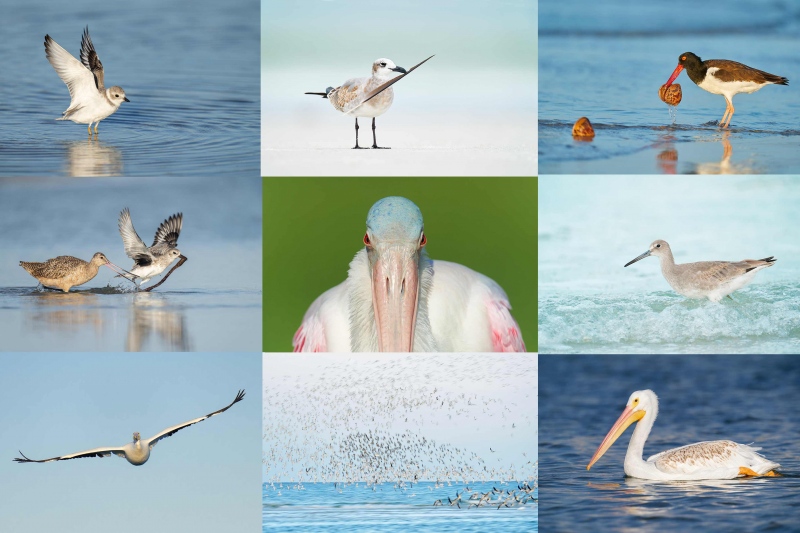


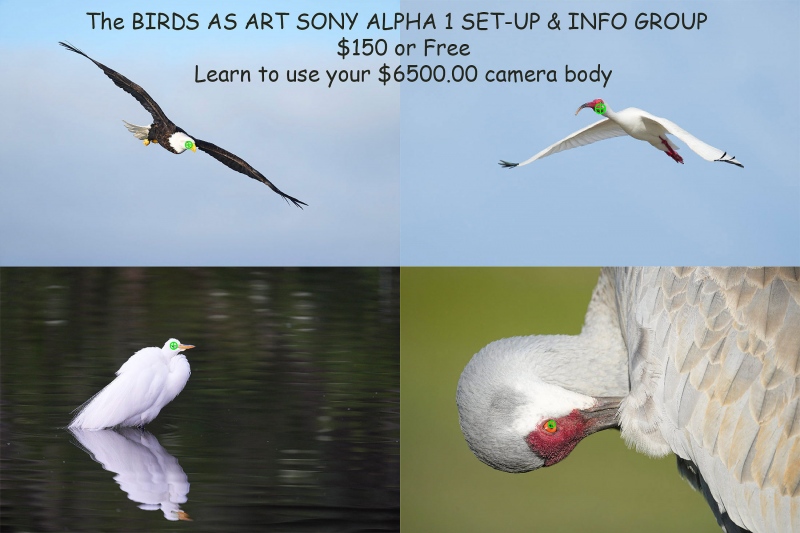
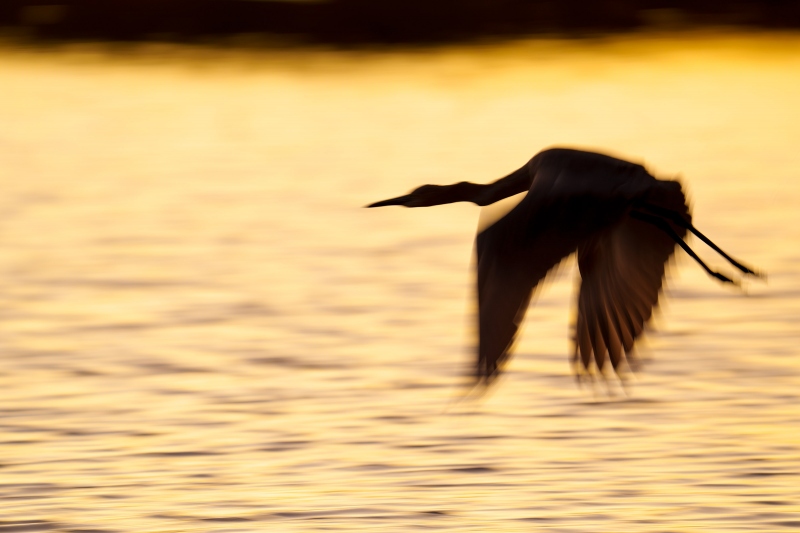
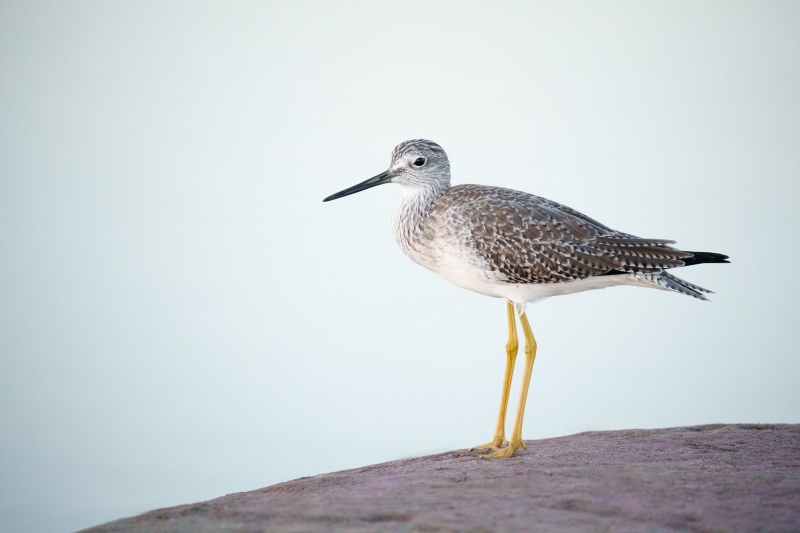
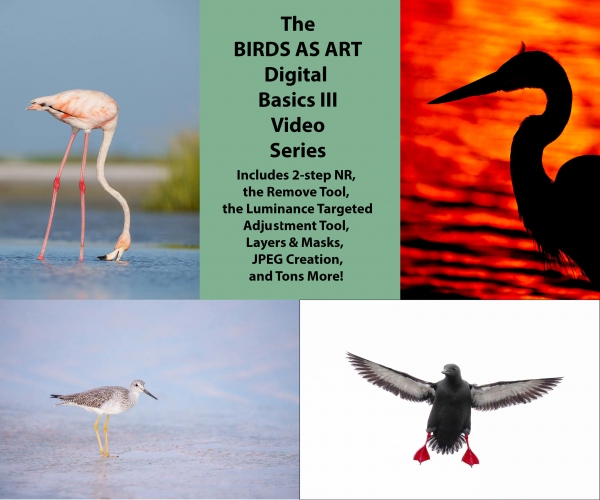

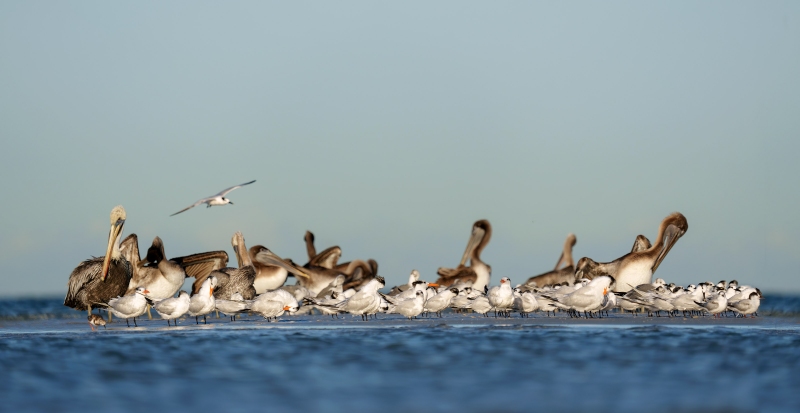













The SONY Alpha a1 Set-up Guide and Info Group has become an invaluable resource for a growing community of a1 users. The initiative’s thoughtful discussions, shared experiences, and the provision of .DAT files for settings make it incredibly convenient for members. This consolidated guide is a must-have for anyone with an a1, simplifying the process and enhancing the user experience.
Many thanks for your kind but accurate words.
with love, a
Image #1 Reddish Egret is so dark even though you can see it flying! Images #2 and #3 and #4 are bright. And image #4 Flock of birds with the mom and the kids is interesting!